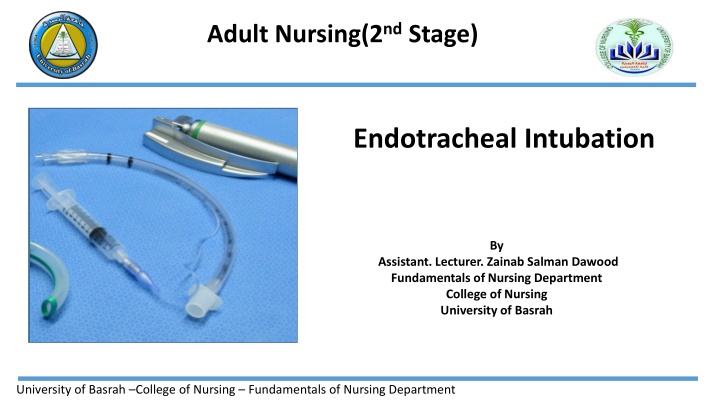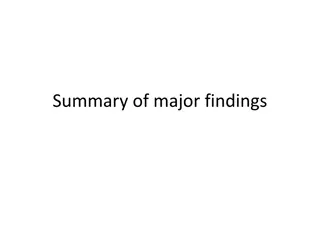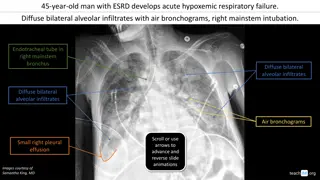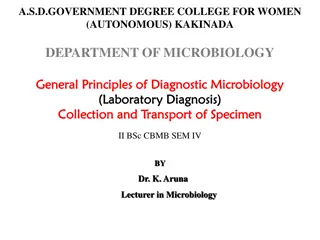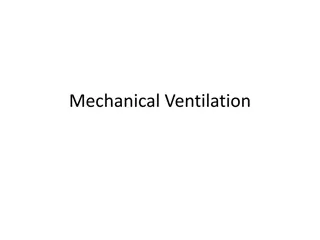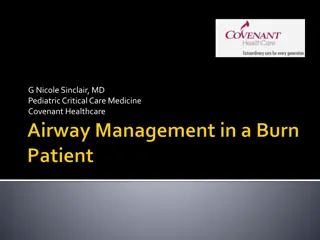Endotracheal Intubation
Endotracheal intubation (EI) is a critical procedure to maintain airway patency and assist patients in breathing effectively. This emergency technique involves placing a flexible tube into the trachea and serves various purposes, including protecting the airway and facilitating anesthesia delivery. Different tube sizes cater to specific patient needs, from newborns to adults, with particular indications for use, such as in surgeries, foreign body removal, and airway protection against aspiration.
Download Presentation

Please find below an Image/Link to download the presentation.
The content on the website is provided AS IS for your information and personal use only. It may not be sold, licensed, or shared on other websites without obtaining consent from the author.If you encounter any issues during the download, it is possible that the publisher has removed the file from their server.
You are allowed to download the files provided on this website for personal or commercial use, subject to the condition that they are used lawfully. All files are the property of their respective owners.
The content on the website is provided AS IS for your information and personal use only. It may not be sold, licensed, or shared on other websites without obtaining consent from the author.
E N D
Presentation Transcript
Adult Nursing(2nd Stage) Endotracheal Intubation By Assistant. Lecturer. Zainab Salman Dawood Fundamentals of Nursing Department College of Nursing University of Basrah University of Basrah College of Nursing Fundamentals of Nursing Department
Introduction Endotracheal intubation (EI) is often an emergency procedure that s performed on people who are unconscious or who can t breathe on their own. endotracheal intubation maintains an open airway and helps prevent suffocation. An endotracheal tube is a flexible plastic tube that is placed through the mouth into the trachea (windpipe) to help a patient breathe. University of Basrah-College of Nursing Fundamentals of Nursing Department
University of Basrah-College of Nursing Fundamentals of Nursing Department
Purpose 1. Protect the airway 2. Open airways to receive anesthesia, medication, or oxygen University of Basrah-College of Nursing Fundamentals of Nursing Department
Sizes Endotracheal tubes come in a number of different sizes ranging from 2.0 millimeters (mm) to 10.5 mm in diameter. ( 8.0 to 9.0 mm) is often used for men (7.0 - 7.5 mm) is often used for women (3.0 - 3.5 mm) is often used for newborns (2.5 to 3.0 mm) used for premature infants. University of Basrah-College of Nursing Fundamentals of Nursing Department
University of Basrah-College of Nursing Fundamentals of Nursing Department
Length (cm) Neonate 6+ weight More than2 years age/2+12 Adult male 21-24 Adult female 18-21 University of Basrah-College of Nursing Fundamentals of Nursing Department
Indications 1) General surgery: With general anesthesia, the muscles of the body including the diaphragm are paralyzed, and placing an endotracheal tube allows the ventilator to do the work of breathing. 2) Foreign body removal 3) To protect the airway against aspiration: endotracheal tube may be placed to help prevent the stomach contents from entering the airways. 4) To visualize the airway if an abnormality of the larynx, trachea, or bronchi is suspected. University of Basrah-College of Nursing Fundamentals of Nursing Department
5) To support breathing if someone is having difficulty breathing due to pneumonia, a pneumothorax, respiratory failure or unconsciousness due to an overdose. 6) Some medical conditions (example Guillain-Barre syndrome) can result in full or partial paralysis of the diaphragm and may require respiratory support. 7) When sedation is required 8) Respiratory distress in premature babies often requires placement of an endotracheal tube and mechanical ventilation. 9) When a higher concentration of oxygen is needed. University of Basrah-College of Nursing Fundamentals of Nursing Department
Contraindication 1) Severe airway trauma that does not permit safe passage. 2) Cervical spine injury. 3) Mallampatic classification of class III /IV or other determination of potential difficulty airway. University of Basrah-College of Nursing Fundamentals of Nursing Department
Equipments 1) Laryngoscope handle and blade 2) Et tube 3) 10 ml syringe 4) Water soluble lubricant 5) Stethoscope 6) Tube fixation device University of Basrah-College of Nursing Fundamentals of Nursing Department
Preparation 1) Before an endotracheal tube is placed, jewelry should be removed, especially tongue piercings. 2) People should not eat or drink before surgery for at least six hours to reduce the risk of aspiration during intubation . 3) Quitting smoking even a day or two before the surgery can lower risk of complications University of Basrah-College of Nursing Fundamentals of Nursing Department
During the Procedure 1) During intubation, a physician usually stands at the head of the bed looking towards the patient's feet and with the patient lying flat. The positioning will vary depending on the setting and whether the procedure is being done with an adult or child. With children, a jaw thrust is often used. 2) The endotracheal tube with the assistance of a lighted laryngoscope is inserted through the mouth after moving the tongue out of the way. University of Basrah-College of Nursing Fundamentals of Nursing Department
University of Basrah-College of Nursing Fundamentals of Nursing Department
University of Basrah-College of Nursing Fundamentals of Nursing Department
3) The scope is then carefully threaded down between the vocal cords and into the lower trachea and insert tube. When it's thought that the endotracheal tube is in the proper location, the doctor will listen to the patient's lungs and upper abdomen to make sure that the endotracheal tube was not inadvertently inserted into the esophagus. University of Basrah-College of Nursing Fundamentals of Nursing Department
University of Basrah-College of Nursing Fundamentals of Nursing Department
4) Other signs that suggest the tube is in the proper position may include seeing chest movement with ventilation and fogging in the tube. When a doctor is reasonably sure the tube is in position, a balloon cuff is inflated to keep the tube from moving out of place. (In infants, a balloon may not be needed). The tube is then taped to the patient's face. University of Basrah-College of Nursing Fundamentals of Nursing Department
University of Basrah-College of Nursing Fundamentals of Nursing Department
After the Procedure After the endotracheal tube is in place and a patient connected to a ventilator, health care providers will continue to monitor the tubing, settings, and provide breathing treatments and suctioning as needed. Careful attention to oral care will also be provided. University of Basrah-College of Nursing Fundamentals of Nursing Department
Complications 1) Short term complication Bleeding Improper placement of the endotracheal tube into the esophagus. If this goes unnoticed, the lack of oxygen to the body could result in brain damage, cardiac arrest, or death. Temporary hoarseness when the tube is removed University of Basrah-College of Nursing Fundamentals of Nursing Department
Injury to the mouth, teeth or dental structures, tongue, thyroid gland, voice box (larynx), vocal cords, windpipe (trachea), or esophagus. Infection Pneumothorax (collapse of a lung) Aspiration of contents of the mouth or stomach during placement which can, in turn, result in aspiration pneumonia Atelectasis: Inadequate ventilation can result in collapse of the smallest of airways, the alveoli resulting in atelectasis (partial or complete collapse of a lung( University of Basrah-College of Nursing Fundamentals of Nursing Department
2) Long term complications Tracheal stenosis, or narrowing of the trachea Tracheomalacia Spinal cord injuries Tracheoesophageal fistula (an abnormal passageway between the trachea and esophagus( Vocal cord paralysis: rare complication that can cause permanent hoarseness University of Basrah-College of Nursing Fundamentals of Nursing Department
Thanks University of Basrah College of Nursing Fundamentals of Nursing Department
